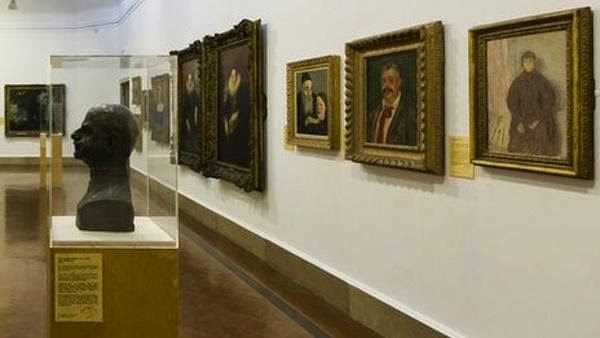The tiny Renoir that was supposedly purchased for $7 at a flea market and captivated art mystery lovers around the world went back on display Thursday at the Baltimore Museum of Art, more than 62 years after it wasstolen from the building.
BMA officials unveiled “On the Shore of the Seine,” a 51 / 2-by-9-inch oil painting, as part of its newest exhibit, “The Renoir Returns.”
“It’s a moment we’ve been looking forward to,” BMA Director Doreen Bolger told a media horde, many of whom wielded cameras larger than the painting.
The museum is hoping to capitalize on the stolen painting’s improbable saga, which generated headlines far and wide and even inspired an episode of “The Simpsons” this month. As part of the fanfare, the BMA launched a blog in which readers are invited to invent fictional chapters about the painting’s theft — the first of which was penned by a renowned Baltimore crime writer, David Simon.
The impressionist landscape, which Pierre-Auguste Renoir painted on a linen napkin for his mistress at a cafe along the Seine in 1879, was originally purchased by longtime BMA donor Saidie A. May at a Paris gallery and donated to the museum in 1937. While it was on exhibit on Nov. 17, 1951, the painting was somehow spirited out of the building. The thief was never found.
Decades passed, and the BMA forgot about the Renoir. The museum lost track of records showing that it had reported the piece stolen, and an insurance claim had been paid.
But in 2012, the Renoir suddenly vaulted into the news when Martha Fuqua — a driving teacher in Loudoun County, Va., who initially concealed her identity with the alias “Renoir Girl” — said she had unwittingly bought the painting at a West Virginia flea market. The Potomack Company, an Alexandria auction house, was scheduled to sell the flea market find for as much as $100,000, which attracted buyers from Japan, China and Europe.
Days before the auction, however, a Washington Post reporter discovered documents at the BMA’s library showing that the museum had once owned and exhibited the painting. Armed with the paperwork, the BMA found records showing that its staff had reported the painting stolen.
The news prompted the auction house to cancel the sale. The FBI seized the Renoir, and questions about the painting’s murky provenance began to mount.
Friends of Fuqua’s mother, Marcia Fouquet, told The Post that they had seen the Renoir hanging in the mother’s Fairfax County home during the 1980s and 1990s. Fouquet, a painter, attended art college in Baltimore at the time of the Renoir’s theft.
Fuqua’s brother, Matt Fuqua, said that before their mother’s death last year, she told her daughter to “return the painting to its rightful owner — the museum — so all of this goes away.”
Martha Fuqua, 52, declined to comment. She battled in federal court to hang on to the painting, arguing that she was an “innocent owner” who could not have known that the painting was stolen. In January, a judge in U.S. Eastern District Court in Alexandria ordered that the painting be returned to the museum.
The FBI said this week that it has closed its investigation into the theft. Gregg Horner, the special agent in charge of the Renoir case, said it was too difficult to track down anyone who might have known about the painting’s theft because so many people who worked at the museum in the 1950s are dead. Horner said he interviewed Fouquet before she died but did not ask her whether she’d had a role in the painting’s disappearance or had the painting hanging in her home.
“She fell ill quickly, and I didn’t feel [asking those questions] was appropriate,” he said.
On Thursday, the painting’s strange journey was part of its appeal.
“The Renoir Returns” features more than 20 artworks May donated to the BMA, including an oil sketch by Georges Seurat she had purchased with “On the Shore of the Seine” at the same Paris art gallery. The exhibit is open only to museum members until Sunday, when it will open to the public. One display case features May’s diary entry in which she writes about having purchased the piece, as well as the $2,000 receipt for the Renoir and the Seurat.
Susan Helen Adler, one of May’s great-great-nieces and the author of May’s biography, said she was grateful that the museum was honoring her ancestor and the Renoir.
“Recognition of what Saidie May did for this museum is long overdue. It’s fantastic,” she said. “It’s unfortunate that it had to be this way, that it took a stolen painting and the publicity around that painting to bring [attention to] what May did for the museum.”
Katy Rothkopf, the museum’s senior curator of European painting and sculpture, said that the Renoir needed only a light cleaning when it was returned. “It was an absolute thrill to finally be able to get it here,” she said. “It’s such a lovely painting, and it really sparkles. It’s going to play such a great role here because it fills out our collection of Renoirs.”
It may also serve as a marketing tool to boost museum membership. In the days leading to the opening of “The Renoir Returns,” the BMA blasted out e-mails with a picture of the gold-framed Renoir. “Join today!” the e-mails urged. “Receive a free Renoir magnet. Plus save 50% on a mug or a print featuring the Renoir.”
A Renoir mug that, no doubt, will wind up one of these days in a flea market.









